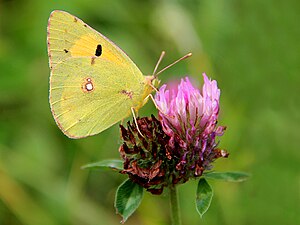Postillon (butterfly)
| Postillon | ||||||||||
|---|---|---|---|---|---|---|---|---|---|---|

Postillon on meadow clover |
||||||||||
| Systematics | ||||||||||
|
||||||||||
| Scientific name | ||||||||||
| Colias croceus | ||||||||||
| ( Geoffroy in Fourcroy , 1785) |
The Postillon , also Postillion , Great Post Squirrel , Yellow Post Squirrel Wander-Gelbling / Wandergelbling or Orange-Red Kleefalter ( Colias croceus , Syn .: C. edusa ), is a butterfly ( Wandermalter ) from the family of the whiteflies (Pieridae).
features
Characteristics of the adults
The postillon has a wingspan of 40 to 50 millimeters. The males have an orange-yellow upper wing surface with a wide dark band at the edge. This marginal band is always severed by yellow veins on the forewings and often on the hindwings, which can be a helpful distinguishing feature from other Colias species in backlight . There is a distinct scented scented spot near the base of the wing in cell 7 of the hind wings . The female has yellow spots in the dark band and the hind wings are gray-yellow with a clearly visible orange spot in the cell.
Both sexes have clearly visible dark spots in the post-disk region on the underside of the forewings . The wing margins are gray-yellow, with the female's entire hind wing being gray-yellow.
Characteristics of the caterpillars
The caterpillar of the postilion is green with a narrow yellow-orange side stripe and resembles the caterpillar of the golden eight ( Colias hyale ).
Subspecies and forms
- Colias croceus f. Helice (Hübner) is a white form of the female that is genetically fixed and occurs in around ten percent of the adults.
Similar species
- The orange-red hay butterfly ( Colias myrmidone ) is usually darker orange and has no veins interrupted by the band. It is widespread in eastern Austria , the Balkans and southern Russia .
- The males of Colias erate are often orange in color, especially in Central Europe. It is widespread from Saxony and Lower Austria through Southeast Europe and temperate Asia to Japan .
- The females of the Golden Eight ( Colias hyale ) and the yellow horseshoe clover ( Colias alfacariensis ) resemble the female of the postilion.
Occurrence
The distribution of the postilion extends from North Africa through South and Central Europe, Turkey and West Asia to Afghanistan . It is also represented on the Mediterranean islands and the Atlantic islands of the Canaries , Azores and Madeira . In Europe the distribution ends at around 60 ° north. The postillon is mainly to be found in warm areas in open terrain up to 2,000 meters above sea level . In Germany it is sighted regularly, but only in a small number of individuals. Since the animal cannot overwinter north of the Alps, it has to immigrate to the northern latitudes. During the hike he was observed at 3,200 meters above sea level.
Way of life
The caterpillars of the postilion feed on the leaves of alfalfa , common horn clover , red vetch and other types of clover and vetch .
Lucerne, meadow clover and meadow knapweed are important sources of nectar for butterflies in summer. In autumn, yellow flowers such as B. Stiff Hairy dandelion , Doldiges - and hawkweed and Catsear important. Among the garden flowers are marigolds ( Tagetes ) approached.
Flight and caterpillar times
The Postillon flies in several generations from April, May until late autumn. The first generation caterpillars can be found from June to July, the second generation from August to September.
swell
Individual evidence
- ↑ lepiforum.de Who described Papilio croceus ?
- ↑ a b Eckstein, The Butterflies of Germany ( Memento from April 26, 2016 in the Internet Archive ) (PDF; 15.5 MB), p. 60, KG Lutz 'Verlag 1913. Retrieved on June 5, 2013.
- ↑ a b Karl Mazzucco, Wanderflug der Butterflies (PDF; 718 kB), p. 56, in: Communications from the Natural Science Working Group House of Nature, Salzburg 1 approx. 1951/52. Retrieved June 5, 2013.
- ^ A b Lionel G. Higgins and Norman D. Rilley, Die Tagfalter Europäische und Nordwestafrikas (A Field Guide to the Butterflies of Britain and Europe) , Paul Parey 1971, ISBN 3-490-02418-4
- ↑ Natural History Information System [1] , (accessed on September 26, 2006)
- ↑ Günter Ebert (Ed.): The butterflies of Baden-Württemberg Volume 1, Tagfalter I (Ritterfalter (Papilionidae), Weißlinge (Pieridae), Edelfalter (Nymphalidae)), Ulmer Verlag Stuttgart 1993. ISBN 3-8001-3451-9
- ↑ Manfred Koch, Wolfgang Heinicke: We determine butterflies. 3. Edition. Neumann, Radebeul 1991, ISBN 3-7402-0092-8 .
literature
- Tom Tolman, Richard Lewington: The butterflies of Europe and Northwest Africa , Franckh-Kosmos Verlags-GmbH & Co, Stuttgart 1998, ISBN 3-440-07573-7
- Hans-Josef Weidemann: Butterfly: observe, determine , Naturbuch-Verlag Augsburg 1995, ISBN 3-89440-115-X
- Manfred Koch : We determine butterflies. Volume 1: Butterfly. 4th enlarged edition. Neumann, Radebeul / Berlin 1966, DNB 457244224 .
- David J. Carter, Brian Hargreaves: Caterpillars and Butterflies of Europe and their Forage Plants. Blackwell Wissenschaftsverlag 1987, ISBN 3-8263-8139-4
Web links
- www.lepiforum.de
- www.schmetterling-raupe.de
- Jürgen Hensle, Walter Hensle: On the question of the frost sensitivity of the caterpillar of Colias crocea (GEOFFROY, 1785). (Lepidoptera, Pieridae)
- Moths and Butterflies of Europe and North Africa
- Markku Savela: Lepidoptera and some other life forms (English)
- Collection of the Natural History Museum Stockholm (Swedish)
- Colias croceus at Fauna Europaea
- Natural history information system


